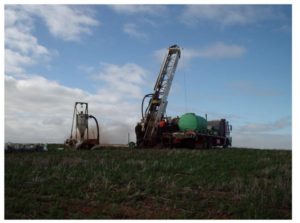Archer’s Jamieson Tank manganese project capable of battery production
Archer Exploration Limited (ASX: AXE), is pleased to announce outstanding results from recent metallurgical test work conducted on a composite drill sample sourced from the Company’s 100% owned Jamieson Tank Manganese Project (located near Cleve, South Australia).
The metallurgical test work was completed by Kemetco Research Inc, the same company that did the Ketchowla manganese and cobalt test work (ASX announcement 12 February 2018), and showed that the Jamieson Tank manganese was capable of making an EMD product with a manganese content of >92%, which is the standard required for alkaline and lithium-ion batteries
The test work involved the leaching of the manganese from the old drill sample provided by Archer, purification of the leach to remove iron, cobalt, nickel and other potentially deleterious elements and finally the precipitation of the electrolytic manganese dioxide onto graphite cathode and titanium anodes.
Executive Chairman, Greg English commented: “It is very exciting that our manganese at Jamieson Tank has been independently shown to be suitable in the production of high-grade manganese EMD, with its high-value applications in emerging and established battery technologies. This is consistent with our expanding exploration portfolio focus on advanced materials and reliable energy storage technologies.” 
Mr English continued: “The Jamieson Tank Manganese Project complements our nearby Campoona graphite and graphene project with its granted mining tenements, and our other manganese and cobalt exploration prospects at Ketchowla and North Broken Hill. We look forward to updating the market on further developments over the coming weeks.”
The Jamieson Tank Manganese Project
The Jamieson Tank Manganese Project straddles two separate tenements both owned by Archer: Carappee Hill (site of the proposed Sugarloaf Graphite Processing Facility) and Waddikee. The Carappee Hill portion was initially drilled by Archer in 2008 with follow up drilling under a joint venture between Archer and the manganese miner and processer OM Holdings Limited (ASX:OMH). The Waddikee portion was drilled under a separate joint venture between OMH and Monax Mining Limited (ASX:MOX).
Archer purchased the Waddikee tenement from Monax in 2014 and now owns all of the Jamieson Tank Manganese Project. The Project extends for approximately 6km in a N-S strike direction and is open along strike. The southern end of Jamieson Tank is within 2km of the proposed Sugarloaf Graphite Processing Plant and also within close proximity of power, water and road infrastructure.
The drill sample provided to Kemetco had a head grade of 12% manganese. Whilst the grade of Jamieson Tank manganese is lower than direct shipping manganese (e.g. Jupiter Mines and South32) the manganese is low in iron and other impurities which makes it suitable for EMD production.
Over 11,000m of drilling was completed by Monax and OMH at Jamieson Tank and Archer is in the process of finalising a maiden manganese Exploration Target which the Company expects to be able to release within the next few weeks.
Electrolytic Manganese Dioxide
While manganese has traditionally been seen as a component in steel alloys, it is the battery applications of Electrolytic Manganese Dioxide (EMD) that are predicted to be the fastest growing segment of manganese production. EMD is a high value manganese product which is a critical component within various applications, especially for lithium ion battery cathode material for electric vehicles.
The global battery market is currently driven by the shift from nickel-based fuel cells to EMD based fuel cells. The high demand for EMD based Li-ion fuel cells is the major factor contributing to the growth of the batteries market. The global EMD market is forecast to grow at a compound annual growth rate of 6.34 % during the period 2018 – 2022, with the USA being the largest consumer of EMD globally at approximately 40%.
One of the most successful Lithium-ion battery systems is a cathode combination of nickel, manganese and cobalt (NMC). The cathode combination ratio of a NMC battery is usually one-third nickel, onethird manganese and one-third cobalt, meaning that the raw material cost is lower than for other options. The NMC cathode is currently being preferred for environmentally friendly, electric vehicles and hybrids, as well as in power tools.
The adoption of solar and wind-power systems across the world is also creating demand for high electric storage capacity batteries, which utilise EMD battery technologies.
In addition, EMD is critical for cathodes in modern alkaline and sodium batteries and in new battery technology developments, such as the Zinc-Manganese battery which is anticipated to become the replacement for the not so environmentally friendly lead/acid automotive starting and lighting market batteries. There is also significant potential in the emerging Lithiated Manganese Dioxide (LMD) Battery (which contains 61% Manganese by weight). LMD batteries are currently being used in the Chevy Volt and Nissan Leaf.
Archer Exploration Limited is creating advanced materials that enable reliable energy, improve human health and shape quantum technologies, ensuring the betterment of modern society.
They explore Australia’s natural resources to find and source the building blocks of modern technology. With projects spanning graphite, magnesite, cobalt and more, we’re transforming our mineral resources into the advanced materials needed to drive the new order of performance required by future industries and technologies.



